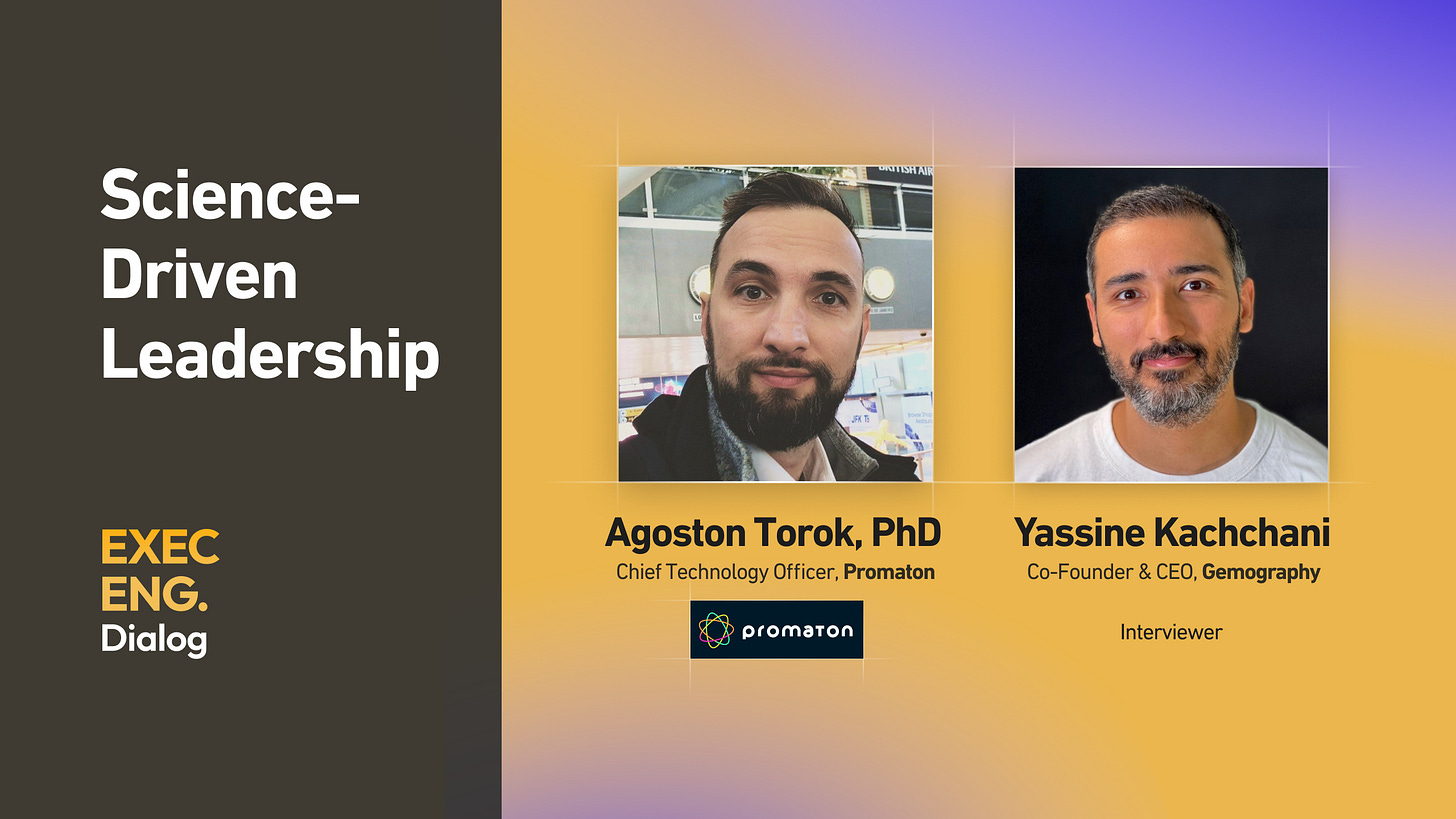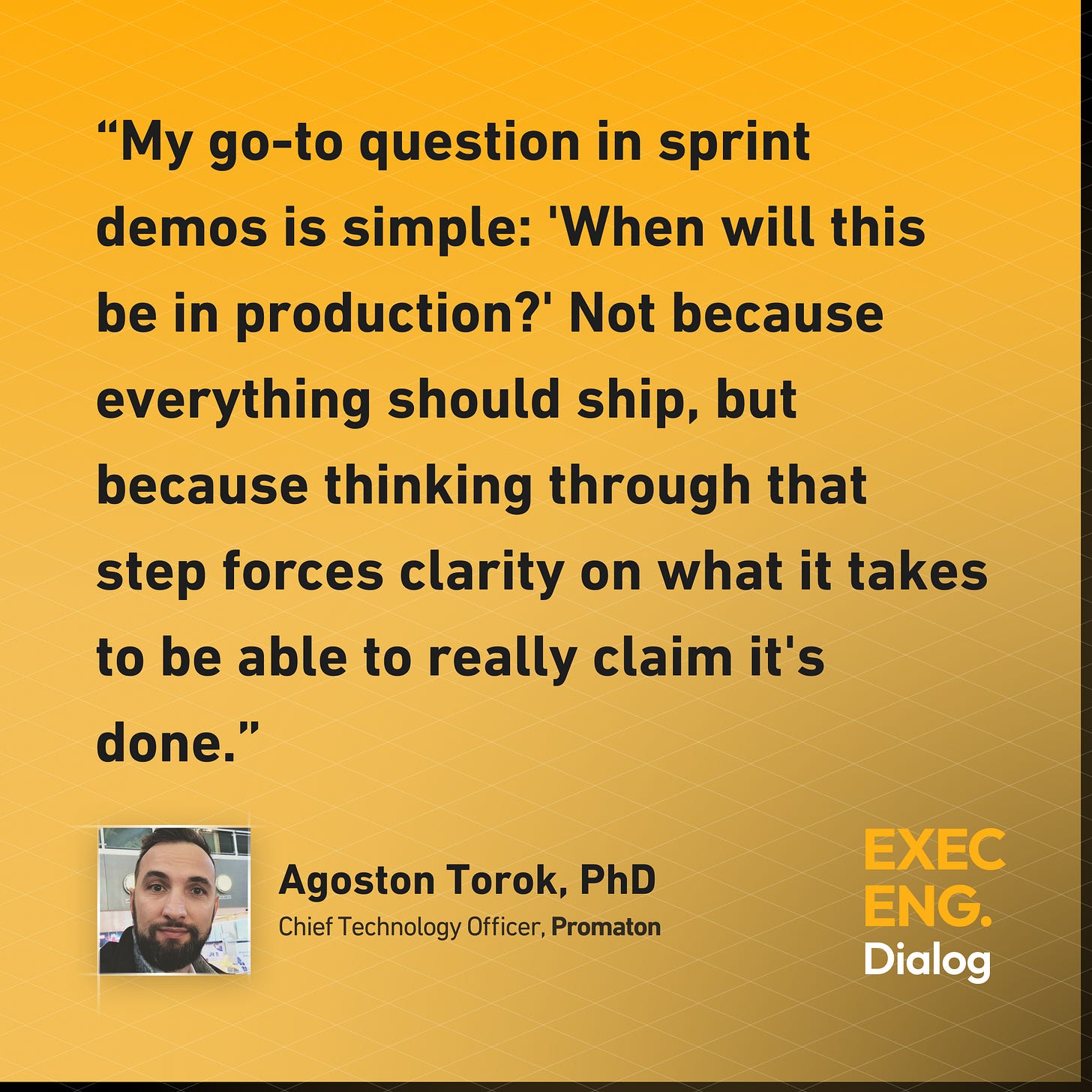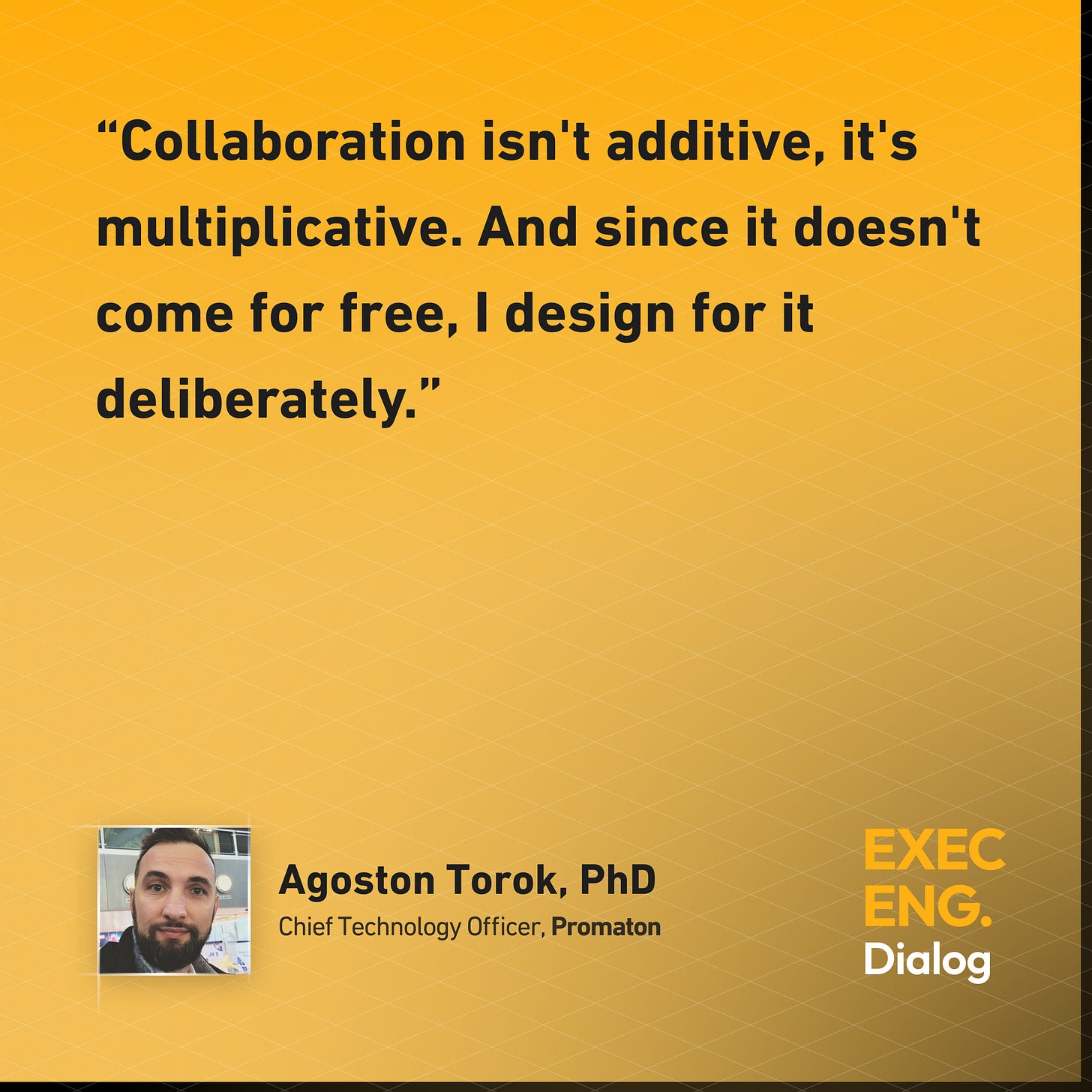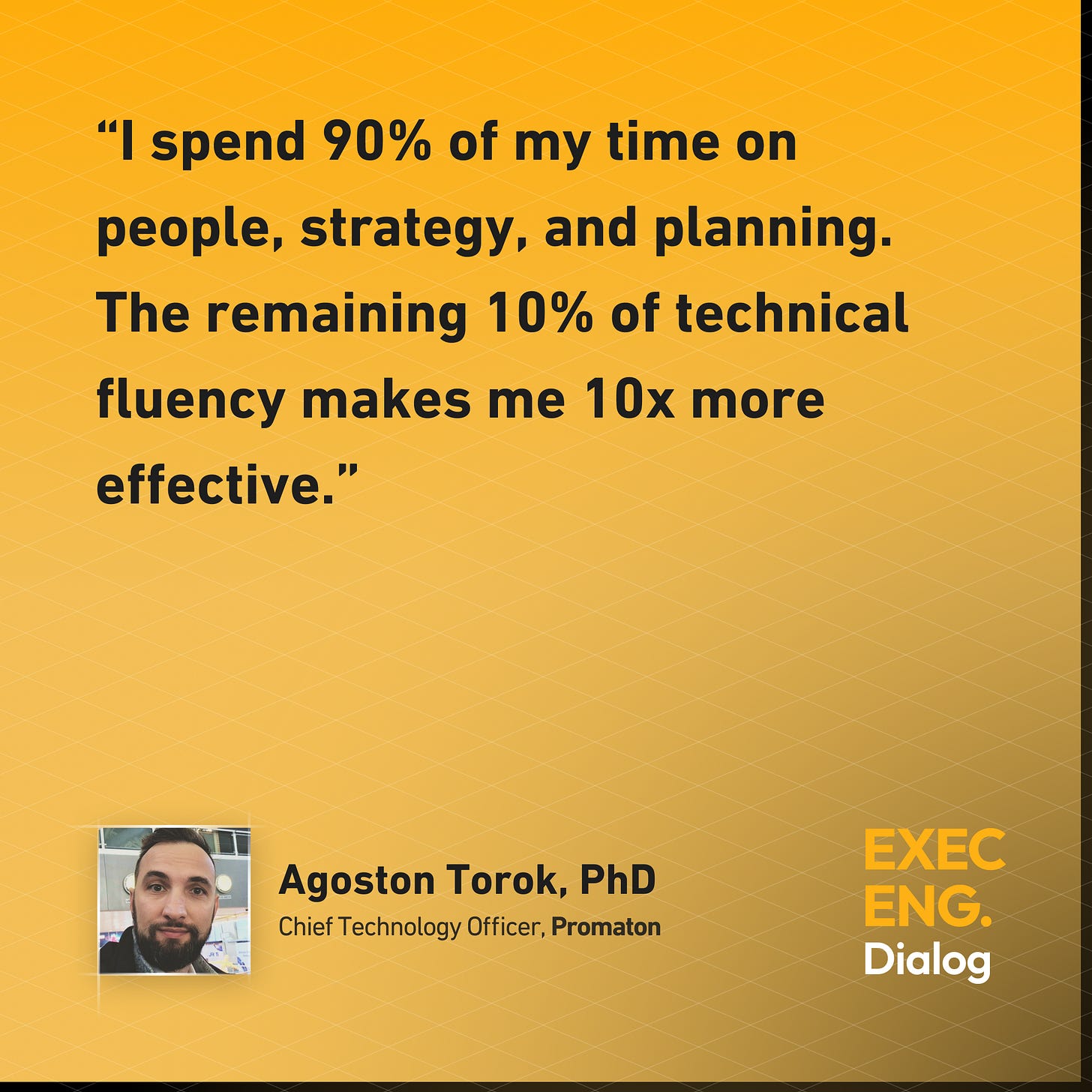Vibe Coding, Psychological Safety, Belief vs. Conviction | Agoston Torok, CTO, Promaton
This week, I’m speaking with Agoston Torok, PhD, CTO at Promaton, where he's revolutionizing dental treatment planning through AI.
With a PhD in cognitive neuroscience and groundbreaking research on human brain navigation, Agoston brings a unique scientific perspective to tech leadership.
Beyond work, he's a creative mind who designs board games, draws comics, and writes thoughtfully about leadership challenges in the AI era.
Takeaways
Belief beats conviction when navigating uncertain technical bets because belief stays open to evidence while conviction becomes rigid and blocks course correction.
Spending 10% of your time staying technically fluent makes you 10x more effective as a leader because you ask better questions and spot risks earlier.
Collaboration multiplies impact rather than just adding to it but only when you deliberately design team structures and processes to make it happen.
Psychological safety means people can say they don’t know or made mistakes without fear but you still give clear feedback and expect growth and accountability.
Yassine: You started your career in neuroscience and research labs. How has your scientific background influenced your leadership style today as CTO? Does that also influence the kind of people you like to work with?
Agoston: Absolutely. Three values from my PhD years shaped how I lead today: a bias for delivery, collaborative execution, and a focus on psychological safety.
In research, discovery is exciting, but impact only happens when ideas are shared, challenged, iterated, and adopted. That's what I mean by "delivery." It's not enough to generate insights or hit metrics. You have to explain the work, iterate based on feedback, and embed it in something useful. That's how science moves forward. And it's the same in product development. My go-to question in sprint demos is simple: "When will this be in production?" Not because everything should ship, but because thinking through that step forces clarity on what it takes to be able to really claim it's done.
The second is collaborative execution. Publishing a strong paper takes an entire crew: the idea person, the implementer, the analyst, the writer, and the domain expert who brings credibility. Real output is a team sport. I've worked with phenomenal 10x engineers, but their impact always multiplied when paired with the right collaborators. I lean hard into this idea. To me, collaboration isn't additive - it's multiplicative. And since it doesn't come for free, I design for it deliberately.
Lastly, psychological safety. In academia, I have seen many brilliant people burn out, suffer in silence, or lose confidence in themselves. I was fortunate during my PhD, but I struggled after. I suffered from imposter syndrome because I didn't come from a traditional software background. But, I had managers who focused on my strengths and gave developmental feedback that was tailored to the unique profile I had. That gave me the energy to wake up every day with the eagerness to learn, so in a few years I worked down my handicap. Now, I build that kind of space for others. I want people to feel safe saying, "I don't know," "I made a mistake," or "I need help" without fear. But psychological safety isn't about being soft. I still give clear, developmental feedback. I still expect people to grow, take accountability, and deliver. The difference is that I tailor my coaching to who they are, not who they 'should' be. I'm not building clones, I'm helping people become the best version of themselves based on their strengths, aspirations, and context. That's how people grow, take smart risks, and get the courage to experiment.
Yassine: Promaton is building medical-grade AI in dentistry, where regulation, safety, and innovation all intersect. What's one tricky product decision you had to navigate, and how did your team align around it?
Agoston: This is indeed a complex field, which explains why many startups struggle to succeed in this market. Creating a DNA that balances regulatory and safety considerations with genuine innovation is a challenging task. Moreover, this DNA isn't established just once; it must be continually reassessed and refined as the team expands and changes, products evolve, and the industry landscape shifts.
At one point, we debated whether to license an existing component or build it ourselves. We chose the hard path and decided to build it. And as usual during the development of any complex thing: progress stalled, results were unclear, and anxiety mounted. Especially from stakeholders wanting clarity about the progress and, in general, return on investment.
So I spent a lot of time with our tech lead, trying to understand: is this really a dead-end, or are we just not seeing the progress yet? Is it a communication problem, where the team is making progress, but it's not being articulated? Or is it a product strategy issue, where we need to course correct entirely? These were not easy conversations.
I had to ensure that what he had was belief and not conviction. See, conviction is rigid, it says: "we must be right". Belief is softer, yet more powerful. It's the willingness to keep pushing while remaining open to evidence that we're wrong. In this case, our tech lead had that belief. My role shifted from directing to supporting. I dug in to understand the reasoning, the failure paths and ultimately, I chose to use my social capital internally to protect the team and buy them time.
It paid off. The component hit a level of performance we hadn't seen before and became one of our strongest differentiators. That said, it wasn't all smooth. There were moments of stakeholder tension that I'll own. But that's part of leading in high-regulation, high-innovation spaces. Sometimes, you have to take short-term heat to create long-term value.
The core lesson for me is that in breakthrough innovation, belief often precedes evidence. And part of the job is knowing when to challenge that belief and when to bet on your people.
Yassine: You "vibe coded" CEO Simulator, a game that attracted 10k+ players over a weekend. As an engineering leader, has this experience shifted what you now expect from individual engineers with AI on their side?
Agoston: Building the CEO Simulator was part technical experiment, part personal growth challenge—and yes, part exploration of how AI is changing the game for engineers.
On the personal side, I had a very specific gap to close. I oversee a wide range of technical areas at Promaton, including ML research, MLOps, infrastructure, backend, and frontend engineering. However, for a long time, my weakest link was the frontend. I had almost no experience in that domain. And while I had some incredible people around me who covered that area with strength, leadership means not outsourcing your understanding entirely. So, I chose a small, creative side project—a web-based simulation game—and used it to explore frontend technologies.
I wanted to internalise not just design patterns and frameworks, but get a 'feel' of building and shipping a UI. I learned a lot about the challenges of frontend work, including security, browser diversity, and differences in testing (e.g., I recorded flows using Puppeteer). These insights now affect the questions I ask, the risks I flag, and how I support our frontend engineers. I'm still no expert, that's for sure, but I'm also not ignorant anymore. I still spend 90% of my time on people, strategy, and planning—but that remaining 10% of technical fluency makes me 10x more effective.
On the AI side, some would argue that what I did with CEO Simulator was not true vibe coding. I reviewed the code after every prompt; heck, I even wrote a few of the parts old-school myself. But that's the point, I wanted to deliver a good game as quickly and efficiently as possible. For this, per definition, "true" vibe coding just didn't cut it, however, AI-coding support with 80% vibe did supercharge my productivity.
That's precisely what I'm looking for in engineers too. I'm not hiring for people who avoid Copilot or ChatGPT; I want engineers who try, measure, adapt, and share what works. One brilliant engineer on our team told me, "I get better results when I ask AI in a chat interface than when I use Copilot." I tried it. She was right. That level of insight, tested in practice, is the behaviour I now reward.
Ultimately, this project reminded me that leadership isn't about stepping back once you've 'made it'; it's about staying close enough to the work to keep evolving with it. AI is changing the tools, the pace, and the expectations, but not what defines great builders. Grit for execution is still key. Collaboration - between humans, or between humans and AI - is still a force multiplier. And courage still matters, maybe more than ever. In fast-moving environments, psychological safety is the fuel but courage is the spark that ignites it into real momentum. That's the kind of team I want to build and the kind of engineer I'll bet on every time.
📚 Agoston Torok's Go-To Resources:
People I follow and recommend:
A newsletter I rarely skip:
A book that shaped my thinking:
Thank you Agoston for your time and insights!
This interview is part of the “Exec Engineering Dialog” series where I interview seasoned tech leaders on the topics of talent, product, management and culture.
If you liked the insights shared in this interview, consider giving feedback and/or sharing it with your network, it’s the best way to help this segment improve and grow.
Yassine.






